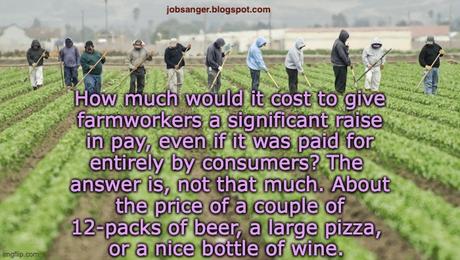
The capitalists controlling our food system would like for you to believe that giving farmworkers (the lowest paid workers in this country) a significant raise in pay, would make the cost of food prohibitive. That is just not true. Even if customers bore the entire cost of that raise for farmworkers, the rise in the cost of food would be minimal.
Here's part of what the Economic Policy Institute says about the cost of raising farmworker pay:
According to studiespublished by the University of California, Davis, farm labor costs are about a third of farm revenue for fresh fruits and vegetables, meaning that farmworker wages and benefits for fresh fruits and vegetables cost the average household $57 per year (0.33 x $173 = $57). (However, in reality, farm labor costs are less than $57 per year per household because over half of the fresh fruits and one-third of fresh vegetables purchased in the United States are imported.)
To illustrate, that means that farm owners and farmworkers together receive only about one-third of retail spending on fruits and vegetables even though most, and in some cases all, of the work it takes to prepare fresh fruits and vegetables for retail sale takes place on farms (the exact share of the price farmers receive varies slightly by crop). For example, strawberries are picked directly into the containers in which they are sold, and iceberg lettuce is wrapped in the field. Consumers who pay $3 for a pound of strawberries are paying about $1 to the farmer, who pays one-third of that amount to farmworkers, 33 cents. For one pound of iceberg lettuce, which costs about $1.20 on average, farmers receive 40 cents and farmworkers get 13 of those 40 cents.
So, what would it cost to raise the wages of farmworkers? One of the few big wage increases for farmworkers occurred after the Bracero guestworker program ended in 1964. Under the rules of the program, Mexican Braceros were guaranteed a minimum wage of $1.40 an hour at a time when U.S. farmworkers were not covered by the minimum wage. Some farmworkers who picked table grapes were paid $1.40 an hour while working alongside Braceros in 1964, and then were offered $1.25 in 1965, prompting a strike. César Chávez became the leader of the strike and won a 40% wage increase in the first United Farm Workers table grape contract in 1966, raising grape workers’ wages to $1.75 an hour.
What would happen if there were a similar 40% wage increase today and the entire wage increase were passed on to consumers? The average hourly earnings of U.S. field and livestock workers were $14 an hour in 2019; a 40% increase would raise their wages to $19.60 an hour.
For a typical household or consumer unit, a 40% increase in farm labor costs translates into a 4% increase in the retail price of fresh fruits and vegetables (0.30 farm share of retail prices x 0.33 farm labor share of farm revenue = 10%; if farm labor costs rise 40%, retail spending rises 4%). If average farmworker earnings rose by 40%, and the increase were passed on entirely to consumers, average spending on fresh fruits and vegetables for a typical household would rise by $25 per year (4% of $615 = $24.60).
Many farm labor analysts consider a typical year of work for seasonal farmworkers to be about 1,000 hours. A 40% wage increase for seasonal farmworkers would raise their average earnings from $14,000 for 1,000 hours of work to $19,600. Many farmworkers have children at home, so for them, going from earning $14,000 to $19,600 per year would mean going from earning about half of the federal poverty line for a family of four ($25,750 in 2019) to earning about three-fourths of the poverty line. For a farmworker employed year-round for 2,000 hours, earnings would increase from $28,000 per year to $39,200, allowing them to earn far above the poverty line.
Raising wages for farmworkers by 40% could improve the quality of life for farmworkers without significantly increasing household spending on fruits and vegetables. If there were productivity improvements as farmers responded to higher labor costs, households could pay even less than the additional $25 per year for fresh fruits and vegetables.
If average farmworker earnings were doubled (rose by 100%) through increased spending on fresh fruits and vegetables, a typical household would see costs rise by $61.50 per year (10% of $615). That extra $61.50 per year would increase the wages of seasonal farmworkers to $28,000 for 1,000 hours of work, taking them above the poverty line for a family of four.

